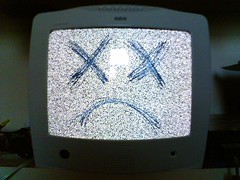(Update at the bottom of the post)
The analogue TV signal in Australia will be switched off by 2013. This means that everyone without a digital tuner will suddenly find themselves free of broadcast television. The date for the switch over has been shifted several times as politicians remained convinced that the digital TV (DTV) adoption rates were so low that it would be a disaster if the signal was turned off as scheduled. I remember when the switch over was going to be sometime in 2005, then 2008, and now it will begin by 2011 and be completed by 2013.
I’ve always been confused about what the fuss is with adoption rates. People won’t rush out and upgrade their TV or buy a tuner until they have to. Just pick a date far in advance, prominently and consistently publicise the date and when the switch date looms, people will upgrade. Tuners are easy to come by, whether they be in a set-top box, built-in tuner in the TV, via pay TV like Foxtel or even a USB tuner for a computer. They’re also quite cheap. A standard definition set-top box can be bought for well under $50 at any large consumer electronics chain and high definition ones (the signal of choice for the Australian market) have started to drop well under $100 for the more dodgy, 90 day warranty, indeterminate country of origin brands.
DTV has many benefits – superior quality transmission and reception of picture and sound, multiple channels, different camera angles, ‘back channel’ possibilities such as e-commerce in the spectrum and so on. Yet, adoption rates remain low. Legislation that restricts ‘narrowcasting’ (the option of tailoring different channels to different market segments) and places strong limits on what broadcasters who are not one of the current free-to-air channels can display has reduced the type of content currently on offer. It seems to me that the market is trying to sell the product purely on the grounds that it will look better.
No wonder adoption rates are so low. Where is the incentive to the consumer, especially the consumer who wants more variety that what is currently offered on the five free-to-air channels but don’t want to be encumbered with a costly monthly subscription for a large number of channels they don’t want?
Following is a final example of the problems with DTV programming in Australia. Channel 7 (and its regional partner, Prime) have the rights to broadcast the 2008 Olympics in Australia. Ch7 has five digital TV channels available to it, covering both standard and high definition spectrum. The Olympics is a perfect showcase for DTV. There are many different sports with different niche markets playing at the same time. Different camera angles would enhance a number of these sports (especially team sports like football and hockey). There is also a healthy portion of the market that couldn’t care less about the Olympics and would like a channel with alternative programming. Obviously the latter could also just watch another station but they are still a market that can be catered to by Ch7.
Have a look at the slideshow below that displays a screenshot of each of the five Ch7 DTV channels over the course of approximately two minutes. Count how many of the different options that DTV technology makes available have been utilised by Ch7.
Five different channels. One picture stream. Where’s the incentive to upgrade?
UPDATE: Mark Pesce reminded me on Twitter that I’d forgotten to mention something in my post, namely that the commercial channels are at the moment prevented from multicasting on their extra DTV channels by legislation. I meant to say this but accidentally removed that paragraph during editing (that’ll teach me to edit my posts). However, I see this situation as just as absurd. If the commercial channels are restriced from innovating in this space, the incentives for consumers to upgrade still are not there. Whether it’s commercial imperative or legislation, the result is still the same – 5 whole channels all showing the exact same thing.
See also:
Interesting article on digital TV in Australia – The Present and Future of Digital TV in Australia [PDF] Dead TV
Photo credit: daedalicious Dead TV



Too bad government official don’t take the time to read consumers feedback about the switch from analog to digital. I work on behalf of SHARP in the US and have had many a laughs about the ridiculous of constantly delaying the switch. ‘Supposedly’ the committed date is coming up early next year but honestly I’ll believe it when I see it. It’s as though their planning a big popcorn movie release or something. I’m with you, the sooner the switch is made the sooner people will all switch over. It’s no secret that people like to put things off and wait until the last minute. Just my thoughts!
Katie,
I’m not very familiar with ‘switch politics’ in the US but I suspect that there are a lot of BigCo entities with a vested interest in maintaining the status quo and who are accomplished at lobbying to get what they want.
I’m lead to believe that in the US very few people get their only TV signal ‘over the air’ and that most already have access to a digital signal of some sort either through cable, fibre or satellite. That would complicate matters also. After all, where is the incentive to pay money to switch when you’re already getting a digital signal.
Consumers don’t just up and switch without being provided some motivation to do so. I wonder why it’s so hard for governments to understand this sometimes.
Pingback: Recent Links Tagged With "dtv" - JabberTags